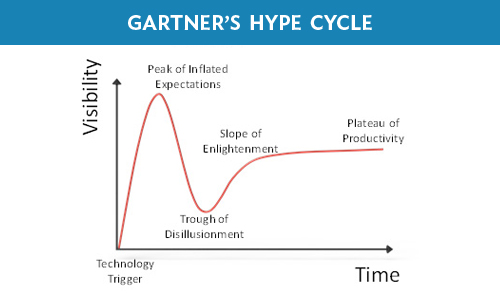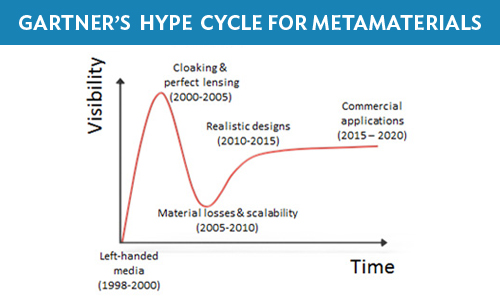“I can’t see what exactly would happen, but I can hardly doubt that when we have some control of the arrangement of things in the small scale, we will get an enormously greater range of possible properties that substances can have.”
Richard Feynman, 1959 “There’s Plenty of Room at the Bottom”
The Gartner Hype Cycle
The Gartner Hyper Cycle presents the visibility of a certain technology as a function of time. It can be applied to most technological breakthroughs, such as the invention of the transistor, the discovery of the laser, or the early stages of the internet (ARPANET). It is shown in the image below and comprises five stages.

The first stage is the “Technology Trigger” – it is a critical point where a new discovery or invention appears and ignites interest in the field. The second stage is the “Peak of Inflated Expectations”, where mass interest is attracted and the potential applications of the technology are considered, usually with unrealistic expectations. The third stage is the “Trough of Disillusionment”, where the original expectations are not met, and the interest in the technology starts to gradually fade. The fourth stage is the “Slope of Enlightenment”, where the technology by now is better understood, and more realistic applications are gradually emerging. Finally, the “Plateau of Productivity” is a phase where mainstream adoption initiates and the use of the technology is clearer.
Note that the “Plateau of Productivity” never reaches the same height as the “Peak of Inflated Expectations”.
The Hype Cycle for Metamaterials
The field of metamaterials could also be viewed through the lens of the Gartner Hype Cycle. Historically, several concepts with light-manipulating properties that would later be covered under the metamaterial umbrella have been introduced throughout the 20th century. Some examples include frequency selective surfaces [1], photonic crystals [2], and the theoretical concept of a left-handed medium[3]. However, significant interest in the field was ignited around the year 2000, due to the publication of several milestone papers, including the experimental verification of a negative index medium[4] and the concept of a perfectly focusing lens[5]. This can be considered the “Technology Trigger” for metamaterials, as shown in the image below.

In the coming years, particularly up to 2005, the field witnessed an explosive growth, attracting the attention of many researchers from diverse fields of physics and engineering. At an academic level, many new concepts were introduced and new physics was demonstrated[6-8]. At the same time, the idea of an invisibility cloak[9] captured the public’s imagination as well.
It soon became clear though that many of these new concepts could not be easily converted into commercial applications, particularly with regards to optical metamaterials. Two of the main reasons for that are the inherent losses which originate from their resonant behavior, their accordingly narrow bandwidth of operation, and the fabrication challenges in scaling the structures to practical sizes more than a couple of wavelengths long. For example, it is now evident that a perfect broadband cloak for any object in the visible range is extremely challenging (if not impossible) to be build[10].
Since about 2010 we have entered a period where researchers have become more aware of these limitations of bulk metamaterials and have started proposing concepts to work around them. One particular promising example is metasurfaces[11], which due to their thin nature do not suffer from the same losses to the same extent as bulk metamaterials. In addition, they can be more easily fabricated, as the recent success of Kymeta for microwave surface metamaterials has shown[12]. We are entering the “Plateau of Productivity”, where such commercial applications are becoming more prominent.
Outlook
Even with the advent of metasurfaces, commercial applications for optical metamaterials will most likely require the development of nanofabrication methods, which can be scaled affordably to large surfaces. Some examples of such potential methodologies include holography, which enables the parallel processing of large structures, and sol-gel, a chemical method that allows precise control of the refractive index using cheap raw materials. In any case, such solutions need to be optimized for optical metamaterial fabrication.
